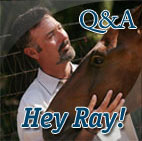Time for first hitch is good time for a training review
10th in a Series
 In prior articles I’ve discussed many preliminary steps needed to prepare your equine for pulling a vehicle, cart or carriage. Before advancing to the first hitch, the driver needs to review these steps and have full confidence — in both their own and in the equine’s abilities. Your equine should have a WHOA/STAND, both verbally and with the lines, as WHOA is the single, most important word a driving equine must know! It must be confidently long-lining while walking and trotting with simulated shafts (long poles); dragging weight of some sort; be tolerant of various noises; and wearing blinders. The horse should also be comfortably wearing a bit, as it is NEVER advisable to drive an equine without a bridle and bit.
In prior articles I’ve discussed many preliminary steps needed to prepare your equine for pulling a vehicle, cart or carriage. Before advancing to the first hitch, the driver needs to review these steps and have full confidence — in both their own and in the equine’s abilities. Your equine should have a WHOA/STAND, both verbally and with the lines, as WHOA is the single, most important word a driving equine must know! It must be confidently long-lining while walking and trotting with simulated shafts (long poles); dragging weight of some sort; be tolerant of various noises; and wearing blinders. The horse should also be comfortably wearing a bit, as it is NEVER advisable to drive an equine without a bridle and bit.
Introducing the harness…piece by piece
I like to introduce the harness a few pieces at a time in this order: saddle, back strap with crupper, then the breeching. This just seems to make sense to the horse, and it’s less overwhelming to his senses. You want to introduce the harness piece by piece, so they won’t get frightened.
Poles and drags: Prep for hitching to a horse drawn vehicle
 Seventh in a series
Seventh in a series
In the old days, a young horse might be put in the hitch (between other more experienced horses), and basically dragged along until he learned his job. In his first week of driving, he might have been driven 40 hours or more.
In our modern world, our equines are for pleasure and rarely used for actual work. Our pleasure horses may not get worked that many hours in a matter of months! This is the reason for such slow, preparatory work. Many equine owners are not trainers and may have minimal knowledge in the discipline of their choice. To be SAFE is to have knowledge. Don’t be in a rush and skip steps. Slow and steady work is best for both equine and human to gain understanding.
More in the round pen: Introducing the harness
 I like to introduce the harness a few pieces at a time, in this order: saddle, back strap with crupper, then the breeching. This just seems to make sense to the horse and is less overwhelming to his senses.
I like to introduce the harness a few pieces at a time, in this order: saddle, back strap with crupper, then the breeching. This just seems to make sense to the horse and is less overwhelming to his senses.
You want to introduce the harness piece-by-piece, so they won’t get frightened. A few times around on the lunge or round pen for each piece is usually sufficient. You simply want the equine to be relaxed and accepting without fear. When introducing the crupper (that’s the part that goes under the tail), it’s important to prepare your horse to relax its tail by gently stretching the tail upwards and letting the horse drop it down without resistance. Rub the underside of your horse’s tail with your hands to get him used to feeling something there. When the tail is in its normal position, the crupper is properly fitted when there are about one to two fingers of room between the underside of the tail and the roll of the crupper. It’s not to be fitted too tight or too loose, which can cause the equine to clamp or swish his tail in discomfort or anxiety. When introducing the crupper for the first time BE CAREFUL, as your horse may clamp his tail, scoot forward, and possibly buck and kick! Do your homework before and desensitize them, and you‘ll have less resistance. You may want to do this the first time in a stall. Don’t punish your horse if he objects — leave him alone to work it out and accept it. The underside of the tail is very sensitive and easily rubbed, so make sure your crupper is clean, not cracked, and of the appropriate size. You might even want to put a piece of sheepskin around it to cushion it.



 Read Columns
Read Columns

